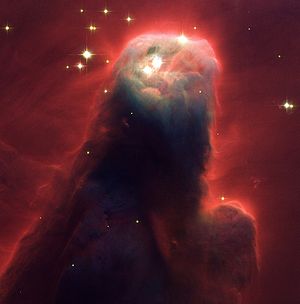- Cone Nebula
-
Cone Nebula 
Taken on April 2, 2002 by the Hubble TelescopeObservation data: J2000.0 epoch Type Diffuse + Dark Right ascension 06h 41m 06s[1] Declination +09° 53′[1] Distance 2,700 ly[2] Apparent magnitude (V) — Apparent dimensions (V) 10 arcmins[1] Constellation Monoceros Physical characteristics Radius 4 ly[3] Absolute magnitude (V) — Notable features Christmas Tree Cluster Other designations NGC 2264 (portion) See also: Diffuse nebula, Lists of nebulae The Cone Nebula is an H II region in the constellation of Monoceros. It was discovered by William Herschel on December 26, 1785, at which time he designated it H V.27. The nebula is located about 800 parsecs or 2,600 light-years away from Earth. The Cone Nebula forms part of the nebulosity surrounding the Christmas Tree Cluster. The designation of NGC 2264 in the New General Catalogue refers to both objects and not the nebula alone.
The diffuse Cone Nebula, so named because of its apparent shape, lies in the southern part of NGC 2264, the northern part being the magnitude-3.9 Christmas Tree Cluster. It is in the northern part of Monoceros, just north of the midpoint of a line from Procyon to Betelgeuse.
The cone's shape comes from a dark absorption nebula consisting of cold molecular hydrogen and dust in front of a faint emission nebula containing hydrogen ionized by S Monocerotis, the brightest star of NGC 2264. The faint nebula is approximately seven light-years long (with an apparent length of 10 arcminutes), and is 2,700 light-years away from Earth.
The nebula is part of a much larger star-forming complex—the Hubble Space Telescope was used to capture images of forming stars in 1997.
The nebula is sometimes referred to as the Jesus Christ Nebula because of its resemblance to Jesus with his hands in a prayer position.
Notes and references
- ^ a b c "SEDS information on NGC2264". Students for the Exploration and Development of Space. http://www.seds.org/messier/xtra/ngc/n2264.html. Retrieved 2009-03-27.
- ^ "Astronomy Picture of the Day". NASA. http://apod.nasa.gov/apod/ap020107.html. Retrieved 2009-03-27.
- ^ 2,700 × sin( 10′ / 2 ) = 3-4 ly. radius
External links
- SEDS information on NGC2264
- Photograph for Astronomy Picture of the Day
- Cone Nebula pictures from ESA-Hubble
- Hubble image of Cone Nebula
Components of NGC 2264 Categories:- NGC 2264
- Dark nebulae
- Diffuse nebulae
- Monoceros constellation
- H II regions
- 1785 in science
Wikimedia Foundation. 2010.
